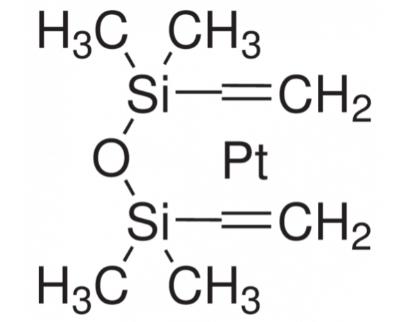Applications of Karstedt Catalysts
Dec 21,2021
Karstedt's catalyst is an organoplatinum compound derived from divinyl-containing disiloxane. This coordination complex is widely used in hydrosilylation catalysis. It is a colorless solid that is generally assumed to be a mixture of related Pt(0) alkene complexes.The catalyst is named after Bruce D. Karstedt, who developed it in the early 1970s while working for General Electric.
Structure
The oxidation state of the platinum is 0. Using X-ray crystallography, the structure of Pt2[(Me2SiCH=CH2)2O]3 has been confirmed. Each Pt(0) center is surrounded by three alkene ligands provided by three 1,1,3,3-tetramethyl-1,3-divinyldisiloxane ligands. The Pt center and six coordinated carbon atoms are approximately coplanar, as found for simpler complexes such as Pt(C2H4)3.

Application
Karstedt catalysts promote a quick, low temperature curing of the hydrosilylation reaction. They form silicone elastomers through an addition curing cross-linking reaction between Si-vinyl and Si-H groups. The fast cure version is a high activity form of Karstedt catalyst promoting rapid curing under ambient conditions, used to cross-link silicone polymers in two-part RTV silicone systems.
Karstedt's catalyst [Ptn(H2C=CHSiMe2OSiMe2CH=CH2)m] is a kind of platinum catalyst which is widely used in the hydrosilylation. Platinum(0)-1,3-divinyl-1,1,3,3-tetramethyldisiloxane complex is a platinum complex, commonly known as a Karstedt′s catalyst. It is generally employed as a catalyst in hydrosilylation reactions. In the catalyst, platinum is in the zero oxidation state with no co-ordinated chlorides.
Carbon-silicon bonds are often generated via hydrosilylation of alkenes. This reaction has very important applications to industry. While it is favorable thermodynamically, hydrosilylation does not proceed in the absence of a catalyst, such as Karstedt's catalyst. The catalyst is produced by treatment of chloroplatinic acid by the divinyltetramethyldisiloxane.
The catalyst can also be used in a reductive amination reaction between a carboxylic acid and an amine with phenylsilane as the reducing agent.
- Related articles
- Related Qustion
- The Role and Synthesis of Platinum(0)-1,3-Divinyl-1,1,3,3-Tetramethyldisiloxane Complexes in Catalysis Mar 6, 2024
Platinum (0) -1,3-diethylene-1,1,3,3-tetramethyldisiloxane, with its excellent stability, reactivity, and selectivity, heralds a new era of catalysis.
- Platinum(0)-1,3-divinyl-1,1,3,3-tetramethyldisiloxane: applications and safety Nov 13, 2023
Platinum(0)-1,3-divinyl-1,1,3,3-tetramethyldisiloxane is a versatile catalyst for hydrosilylation, widely used in various industries. Caution should be exercised due to its flammability.
Fluazinam is a low-toxicity fungicide of 2,6-dinitroaniline developed by Japan Ishihara Co., Ltd. It is effective against Alternaria, Botrytis, plant-eating mites and cruciferous plant root swelling.....
Dec 21,2021Chemical pesticides ?Taxifolin, a chemical substance extracted from pine plants such as larch and Douglas fir. It belongs to the bioflavonoid pseudo-vitamin P, and its scientific name is dihydroquercetin.....
Dec 22,2021APIYou may like
- Tris(dibenzylideneacetone)dipalladium: uses and Health effect
May 9, 2024
- polypropylene vs polycarbonate
Mar 18, 2024
- What is sodium chlorite used for?
Mar 16, 2024
Platinum(0)-1,3-divinyl-1,1,3,3-tetramethyldisiloxane manufacturers
- Platinum(0)-1,3-divinyl-1,1,3,3-tetramethyldisiloxane
-

- $10.00 / 1kg
- 2024-05-24
- CAS:68478-92-2
- Min. Order: 1kg
- Purity: 99%
- Supply Ability: 20ton
- Platinum(0)-1,3-divinyl-1,1,3,3-tetramethyldisiloxane
-

- $6.00 / 1KG
- 2024-03-29
- CAS:68478-92-2
- Min. Order: 1KG
- Purity: 99%
- Supply Ability: g-kg-tons, free sample is available
- Platinum(0)-1,3-divinyl-1,1,3,3-tetramethyldisiloxane
-

- $54.00 / 5g
- 2024-02-23
- CAS:68478-92-2
- Min. Order: 5g
- Purity: 0.98
- Supply Ability: 25kg




